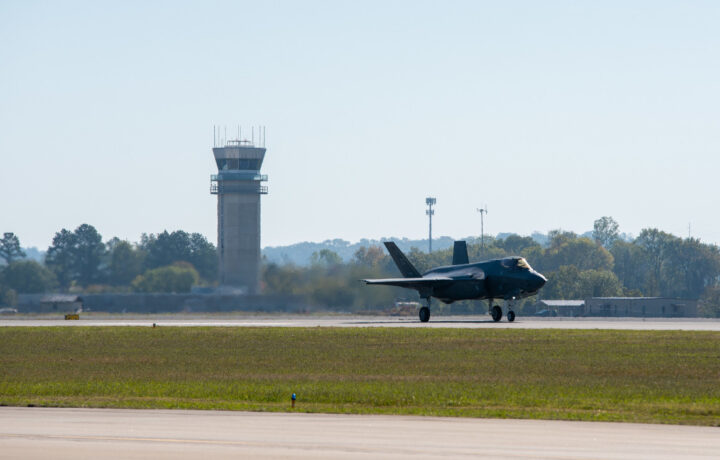Those who live near large American military bases should get used to hearing a variety of accents – and not just from different parts of the United States. Personnel from foreign militaries regularly train alongside those in the various branches of the U.S. military, and soon the Arkansas Air National Guard’s Ebbing Air National Guard Base will be welcoming pilots from allied and partner nations, who will come to train on the fifth-generation Lockheed Martin F-35 Lightning II.
Last November, the Air Force Installation and Mission Support Center (AFIMSC) announced that it was leading a $500 million facilities construction project to facilitate expeditionary skills training and military pilot training as part of the National Defense Strategy’s focus on collaboration between the U.S. and its allies. That project established a permanent F-35 training center for aviators from Singapore and NATO member nations that purchase the Lightning II under the Foreign Military Sales (FMS) program.
As part of the effort, Ebbing was slated to become a new location for the 425th Fighter Squadron, a Republic of Singapore Air Force F-16 Fighting Falcon training unit that had been based at Luke Air Force Base (AFB), AZ.
Poland and Singapore are the first nations to have their aviators head to Ebbing for training on the F-35, while Finnish, German, and Swiss pilots will also use the base in their respective F-35 Lightning II training. Around two dozen F-35s are being deployed to Ebbing to aid its training efforts. Up to a dozen of Singapore’s F-16s will also call Ebbing home.
Until 2013, Ebbing was an A-10 Thunderbolt II base.
The Best Fighter Needs the Best Trainers
The F-35 has been widely touted by some aviation experts as among the best – if not the very best – multirole fighter in service today. It has been adopted or at least on order by 18 nations around the world, and by the early 2030s could be the most widely adopted modern fighter of U.S. partners.
That fact could help ensure greater capability with allies and partners, but the best fighter also requires the best trainers and systems. Foreign pilots come to the United States to receive instruction on the F-35 before the aircraft enters service in their respective nation’s air force.
“This is really about increasing the capability and capacity of our allies and partners,” David Skalicky, who oversees the project as commander of the 33rd Fighter Wing at Eglin AFB, FL, told the Air Force Times this month. He added that learning from U.S. trainers can help make the international coalition of F-35 operators far sharper in combat.
Trainees will actually split their time at Elgin and then Ebbing. Trainees will begin the seven-month training, including on simulators and in classrooms where they’ll learn the controls and tactics at Elgin, before heading to Ebbing to train on the real deal.
Some of the foreign pilots will eventually return to their homelands and be among the first F-35 aviators from their nation’s air force. However, others may be deployed to Eglin for further training to become instructor pilots to build domestic training pipelines for future F-35 aviators.
Ebbing Upgrades Were Required
Moving even some of the F-35 training to Ebbing has come with a few challenges, including that it will require new infrastructure including reinforced runways as some of the F-35s that will be operated at the base will be the F-35B short takeoff and vertical landing (STOVL) variant. The added thrust during landings will put extra pressure on the runways.
The first foreign pilots to go through the training will have to settle for more makeshift facilities, which include an array of trailers and tension-fabric shelters on base. As the Air Force Times also reported, the temporary facilities will tide over the training enterprise for a few years as the service renovates existing spaces that will eventually include maintenance shops, while Joint Strike Fighter-specific facilities are built for the simulators and storage.
“It is a complex and large program that necessitates careful planning and construction of different facilities to line up with when the different countries will arrive for training,” John Ahern, program manager at AFCEC explained last fall when the Air Force first announced that Ebbing would be the new training base for the F-35. “Because we can’t build that quick, we’ll be leasing relocatable facilities to ensure the mission starts while MILCON construction is completed.”
Most of the facilities that will support the F-35 FMS aircraft will be new MILCON construction, while bed down of the F-16s at Ebbing will require renovation and modernization of current infrastructure
Arkansas Welcomes the F-35 Pilots
Officials from the Bear State have expressed gratitude that Arkansas was selected as an F-35 training center for foreign pilots.
“The State of Arkansas has a long history of supporting our military and its missions, which are major economic drivers in Arkansas,” said Arkansas Economic Development Council director of military affairs Retired Air Force Col. Robert Ator in a late March statement.
“The addition of hosting the Republic of Singapore Air Force and the F-35 Foreign Military Sales Pilot Training Center only furthers that history and emphatically places Arkansas on the international stage for strategic deterrence, using the world’s most technologically advanced aircraft,” added Ator. “This basing action is an example of the local community, the State of Arkansas, and the United States Air Force working together for our shared future and the stability of the globe at a time of great strategic competition.”




